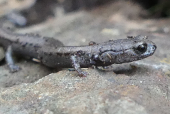Sequoia Slender Salamander (Batrachoseps kawia)
Description: Adults are 1 1/4 - 1 7/8 inches long from snout to vent. A small slim salamander, with 18-20 costal grooves.
Short limbs, a narrow head, long slender body, very long tail, and conspicuous costal and caudal grooves give this species the worm-like appearance typical of most Slender Salamanders. There are four toes on the front and hind feet, which is also typical of Slender Salamanders. (Other California salamanders have five toes on the hind feet.) Dark brown or black above with a brownish or rusty dorsal stripe which is usually absent or not apparent. Whitish speckling is extensive, especially on the sides. Venter is gray and lighter than the sides.
Habitat: The sequoia slender salamander's natural habitat is in riparian woodlands and temperate coniferous forests in the western Sierra.
Range: This salamander is endemic the watershed of the Kaweah River at elevations from 1,600 feet up to 7,200 feet in the Sierra Nevada.
Found in these States:
CA
Diet: Probably eats a variety of invertebrates. Feeding behavior is not known, but other Batrachoseps species are sit-and-wait predators that use a projectile tongue to catch prey.
Reproduction: Reproduction is terrestrial. LIttle is known about the breeding behavior of this species. Other Batrachoseps species lay eggs in moist places on land. Young develop completely in the egg and hatch fully formed.
Status: Listed as Near Threatened since this species has an extent of occurrence (EOO) of 1,662 km2, and occurs in only one location when considering the increasing threat of bushfires. Its population appears to be stable at present, however the frequency and severity of fires are projected to increase as a consequence of climate change resulting in the potential for future decline in habitat quality as well as the number of mature individuals. For example, an unprecedented short period between fire events in the future could drive the species to Endangered in a very short time.
»» Kingdom: Animalia - Animals
»» Phylum: Chordata - Chordates
»» Subphylum: Vertebrata - Vertebrates
»» Class: Amphibia - (Amphibians)
»» Order: Caudata - Salamanders
»» Family: Plethodontidae - Lungless Salamanders
»» Genus: Batrachoseps
»» Species: Batrachoseps kawia - Sequoia Slender Salamander
This article uses material from the Wikipedia article "Sequoia Slender Salamander", which is released under the Creative Commons Attribution-Share-Alike License 3.0. Content may have been omitted from the original, but no content has been changed or extended.
|







